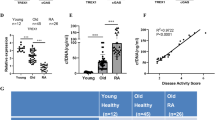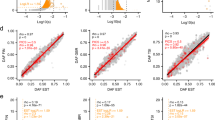Abstract
In this study, we sought to determine the effect of the quantitative trait locus Pia7 on arthritis severity. The regulatory locus derived from the arthritis-resistant E3 rat strain was introgressed into the arthritis-susceptibility DA strain through continuous backcrossing. Congenic rats were studied for their susceptibility to experimental arthritis using pristane and adjuvant oil. In addition, cell number and function of various leukocyte populations were analyzed either under naive or stimulated conditions. We found that the minimal congenic fragment of DA.E3-Pia7 rats overlapped with the minimal fragment in DA.PVG-Oia2 congenic rats, which has been positionally cloned to the antigen-presenting lectin-like receptor complex (APLEC) genes. DA.E3-Pia7 congenic rats were protected from both PIA and OIA, but the protection was more pronounced in OIA. In adoptive transfer experiments we observed that the Pia7 locus controlled the priming of arthritogenic T cells and not the effector phase. In addition, Pia7 congenic rats had a significant higher frequency of B cells and granulocytes as well as TNFα production after stimulation, indicating a higher activation state of cells of the innate immune system. In conclusion, this study shows that the APLEC locus is a major locus regulating the severity of experimentally induced arthritis in rats.
This is a preview of subscription content, access via your institution
Access options
Subscribe to this journal
Receive 6 digital issues and online access to articles
$119.00 per year
only $19.83 per issue
Buy this article
- Purchase on Springer Link
- Instant access to full article PDF
Prices may be subject to local taxes which are calculated during checkout





Similar content being viewed by others

References
Firestein GS . Immunologic mechanisms in the pathogenesis of rheumatoid arthritis. J Clin Rheumatol 2005; 11: S39–S44.
Worthington J . Investigating the genetic basis of susceptibility to rheumatoid arthritis. J Autoimmun 2005; 25 (Suppl): 16–20.
Plenge RM, Seielstad M, Padyukov L, Lee AT, Remmers EF, Ding B et al. TRAF1-C5 as a risk locus for rheumatoid arthritis—a genomewide study. N Engl J Med 2007; 357: 1199–1209.
Wellcome Trust Case Control Consortium. Genome-wide association study of 14 000 cases of seven common diseases and 3000 shared controls. Nature 2007; 447: 661–678.
Vingsbo-Lundberg C, Nordquist N, Olofsson P, Sundvall M, Saxne T, Pettersson U et al. Genetic control of arthritis onset, severity and chronicity in a model for rheumatoid arthritis in rats. Nat Genet 1998; 20: 401–404.
Olofsson P, Holmberg J, Pettersson U, Holmdahl R . Identification and isolation of dominant susceptibility loci for pristane-induced arthritis. J Immunol 2003; 171: 407–416.
Nordquist N, Olofsson P, Vingsbo-Lundberg C, Petterson U, Holmdahl R . Complex genetic control in a rat model for rheumatoid arthritis. J Autoimmun 2000; 15: 425–432.
Griffiths MM, Wang J, Joe B, Dracheva S, Kawahito Y, Shepard JS et al. Identification of four new quantitative trait loci regulating arthritis severity and one new quantitative trait locus regulating autoantibody production in rats with collagen-induced arthritis. Arthritis Rheum 2000; 43: 1278–1289.
Lorentzen JC, Glaser A, Jacobsson L, Galli J, Fakhrai-rad H, Klareskog L et al. Identification of rat susceptibility loci for adjuvant-oil-induced arthritis. Proc Natl Acad Sci USA 1998; 95: 6383–6387.
Flornes LM, Bryceson YT, Spurkland A, Lorentzen JC, Dissen E, Fossum S . Identification of lectin-like receptors expressed by antigen presenting cells and neutrophils and their mapping to a novel gene complex. Immunogenetics 2004; 56: 506–517.
Lorentzen JC, Flornes L, Eklow C, Backdahl L, Ribbhammar U, Guo JP et al. Association of arthritis with a gene complex encoding C-type lectin-like receptors. Arthritis Rheum 2007; 56: 2620–2632.
Holmberg J, Tuncel J, Yamada H, Lu S, Olofsson P, Holmdahl R . Pristane, a non-antigenic adjuvant, induces MHC class II-restricted, arthritogenic T cells in the rat. J Immunol 2006; 176: 1172–1179.
Vingsbo C, Sahlstrand P, Brun JG, Jonsson R, Saxne T, Holmdahl R . Pristane-induced arthritis in rats: a new model for rheumatoid arthritis with a chronic disease course influenced by both major histocompatibility complex and non-major histocompatibility complex genes. Am J Pathol 1996; 149: 1675–1683.
Kleinau S, Klareskog L . Oil-induced arthritis in DA rats passive transfer by T cells but not with serum. J Autoimmun 1993; 6: 449–458.
Holmdahl R, Goldschmidt TJ, Kleinau S, Kvick C, Jonsson R . Arthritis induced in rats with adjuvant oil is a genetically restricted, alpha beta T-cell dependent autoimmune disease. Immunology 1992; 76: 197–202.
Joe B . Quest for arthritis-causative genetic factors in the rat. Physiol Genomics 2006; 27: 1–11.
Olofsson P, Lu S, Holmberg J, Song T, Wernhoff P, Pettersson U et al. A comparative genetic analysis between collagen-induced arthritis and pristane-induced arthritis. Arthritis Rheum 2003; 48: 2332–2342.
Backdahl L, Guo JP, Jagodic M, Becanovic K, Ding B, Olsson T et al. Definition of arthritis candidate risk genes by combining rat linkage-mapping results with human case control association data. Ann Rheum Dis 2008; 68: 1925–1932, (e-pub ahead of print 23 December 2008; doi: 10.1136/ard.2008.090803).
Rintisch C, Holmdahl R . DA rats from two colonies differ genetically and in their arthritis susceptibility. Mamm Genome 2008; 19: 420–428.
Guo JP, Backdahl L, Marta M, Mathsson L, Ronnelid J, Lorentzen JC . Profound and paradoxical impact on arthritis and autoimmunity of the rat antigen-presenting lectin-like receptor complex. Arthritis Rheum 2008; 58: 1343–1353.
Gibbs RA, Weinstock GM, Metzker ML, Muzny DM, Sodergren EJ, Scherer S et al. Genome sequence of the Brown Norway rat yields insights into mammalian evolution. Nature 2004; 428: 493–521.
Olofsson P, Holmberg J, Tordsson J, Lu S, Akerstrom B, Holmdahl R . Positional identification of Ncf1 as a gene that regulates arthritis severity in rats. Nat Genet 2003; 33: 25–32.
Brennan FM, McInnes IB . Evidence that cytokines play a role in rheumatoid arthritis. J Clin Invest 2008; 118: 3537–3545.
Guo JP, Verdrengh M, Tarkowski A, Lange S, Jennische E, Lorentzen JC et al. The rat antigen-presenting lectin-like receptor complex influences innate immunity and development of infectious diseases. Genes Immun 2009; 10: 227–236.
Quinn MT, Ammons MC, Deleo FR . The expanding role of NADPH oxidases in health and disease: no longer just agents of death and destruction. Clin Sci (London) 2006; 111: 1–20.
Truett GE, Heeger P, Mynatt RL, Truett AA, Walker JA, Warman ML . Preparation of PCR-quality mouse genomic DNA with hot sodium hydroxide and tris (HotSHOT). Biotechniques 2000; 29: 52–54.
Holmdahl R . Genetic analysis of mouse models for rheumatoid arthritis. In: Adolph KW (ed). Human Genome Methods. CRC Press: New York, 1997, pp 215–238.
Acknowledgements
This work has been supported by grants from the Swedish Research Council, the Swedish Association against Rheumatism, the Swedish Foundation for Strategic Research and European Union Grants MUGEN (LSHG-CT-2005–005203), AUTOCURE (LSHM-CT-2005-018661) and EURATools (European Commission contract no. LSHG-CT-2005-019015).
Author information
Authors and Affiliations
Corresponding author
Ethics declarations
Competing interests
The authors declare no conflict of interest.
Additional information
Supplementary Information accompanies the paper on Genes and Immunity website
Supplementary information
Rights and permissions
About this article
Cite this article
Rintisch, C., Kelkka, T., Norin, U. et al. Finemapping of the arthritis QTL Pia7 reveals co-localization with Oia2 and the APLEC locus . Genes Immun 11, 239–245 (2010). https://doi.org/10.1038/gene.2010.2
Received:
Revised:
Accepted:
Published:
Issue Date:
DOI: https://doi.org/10.1038/gene.2010.2
Keywords
This article is cited by
-
Rat models of human diseases and related phenotypes: a systematic inventory of the causative genes
Journal of Biomedical Science (2020)
-
Identification of candidate risk gene variations by whole-genome sequence analysis of four rat strains commonly used in inflammation research
BMC Genomics (2014)
-
Anti-MOG antibodies are under polygenic regulation with the most significant control coming from the C-type lectin-like gene locus
Genes & Immunity (2013)


